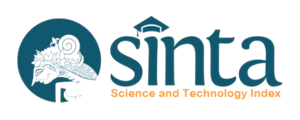DEVELOPING ASSESSMENT INSTRUMENTS FOR ENGLISH LITERACY IN BLENDED LEARNING FOR JUNIOR HIGH SCHOOL STUDENTS
(1) Universitas Pendidikan Ganesha
(2) Universitas Pendidikan Ganesha
(3) Universitas Pendidikan Ganesha
(*) Corresponding Author
Abstract
This research intended to develop assessment instruments for English literacy in blended learning. The study employed survey, observation, interview, and document study as the methods with a questionnaire, observation checklist, interview guide, and school document as the instruments to collect the data framed within RnD design with the 4D model by Thiagarajan et al. The developed instruments were categorized as ‘very high validity’ and ‘very good’ for their content validity (1.00) and product quality (96% and 98%) by the two judges. It indicates that assessment of learning, assessment for learning, and assessment as learning combined with authentic materials are necessary to improve the learning process as well as the students’ English literacy skills. It also implies that English teachers need to highlight the use of assessment for learning and assessment as learning since those assessments lack attention previously.
Keywords
Full Text:
PDFReferences
Ahmad, T. S. A. S., & Hussin, A. A. (2017). Application of the Bloom’s taxonomy in online instructional games. International Journal of Academic Research in Business and Social Sciences, 7(4), 1009-1020. http://dx.doi.org/10.6007/IJARBSS/v7-i4/2910
Argina, A. W., Mitra, D., Ijabah, N., & Setiawan, R. (2017). Indonesian PISA result: What factors and what should be fixed? The 1st Education and Language International Conference Proceedings Center for International Language Development of Unissula, 69-79.
Ayunin, Q., Mirizon, S., & Rosmalina, I. (2019). PISA reading literacy performance and its correlation with engagement in reading activity and reading interest. International Seminar and Annual Meeting BKS-PTN Wilayah Barat, 1(1), 573-585.
Bloom, B. S. (1956). Taxonomy of educational objectives handbook: Cognitive domain. New York: McKay.
Candiasa, I. M. (2010). Statistik univariat dan bivariat disertai aplikasi SPSS. Singaraja: Universitas Pendidikan Ganesha.
Dann, R. (2014). Assessment as learning: Blurring the boundaries of assessment and learning for theory, policy and practice. Assessment in Education: Principles, Policy & Practice, 21(2), 149-166.
Dewantara, I. P. M., Suandi, I. N., Rasna, I. W., & Putrayasa, I. B. (2019). Cultivating students’ interest and positive attitudes towards Indonesian language through phenomenon-text-based information literacy learning. International Journal of Instruction, 12(2), 147-162.
Fithriyah, F. (2015). The importance of authentic materials in developing appropriate and effective listening skills. PIONIR: Jurnal Pendidikan, 4(2), 1-15. http://dx.doi.org/10.22373/pjp.v4i2.180
Hariyadi, A., & Yanti, D. R. (2019). The importance of needs analysis in materials development. Jurnal Ilmiah Profesi Pendidikan, 4(2), 94-99. https://doi.org/10.29303/jipp.v4i2.88
Hutapea, L. S., Lubis, M., & Adisaputera, A. (2020). The development of authentic assessment instruments on anecdotal text material for class X students of SMK Yapim Indrapura, Batu Bara Regency. Budapest International Research and Critics in Linguistics and Education Journal, 3(4), 1826-1814. https://doi.org/10.33258/birle.v3i4.1379
Keefe, E. B., & Copeland, S. R. (2011). What is literacy? The power of a definition. Research & Practice for Persons with Severe Disabilities, 36(3-4), 92-99. https://doi.org/10.2511/027494811800824507
Khairuddiniyah, K. (2017). The implementation of literacy strategies in teaching English by the English teacher at MAN Insan Cindekia Padang Pariaman. English Education: Jurnal Tadris Bahasa Inggris, 10(2), 242-257.
Koksal, D., & Ulum, O. G. (2018). Language assessment through Bloom’s taxonomy. Journal of Language and Linguistic Studies, 14(2), 76-88.
Krashen, S. D. (1982). Principles and practice in second language acquisition. Oxford: Pergamon Press Inc.
Lam, R. (2018). Understanding assessment as learning in writing classrooms: The case of portfolio assessment. Iranian Journal of Language Teaching Research, 6(3), 19-36.
Lee, I., & Mak, P. (2014). Assessment as learning in the language classroom. Assessment and Learning, 3, 66-78.
Mulia, V. L. C. (2016). The contributions of literacy skills to national development. Leksema, 1(2), 111-118. https://doi.org/10.22515/ljbs.v1i2.101
Mutch, C. (2012). Assessment for, of and as learning: Developing a sustainable assessment culture in New Zealand schools. Policy Futures in Education, 10(4), 374-385. https://doi.org/10.2304/pfie.2012.10.4.374
Nurdiana, N. (2018). An evaluation of revised Bloom’s taxonomy on a general English test for non-English major students. Journal of English Teaching as a Foreign Language, 4(1), 33-46.
Nurdiana, N. (2020). Language teacher assessment literacy: A current review. Journal of English Language and Culture, 11(1), 66-74. http://dx.doi.org/10.30813/jelc.v11i1.2291
Octoria, D., Sudiyanto, S., Witurachmi, S., & Wardani, D. K. (2016). The implementation of Bloom’s taxonomy in the assessment instrument for economics learning to improve the students’ cognitive competencies. Proceeding The 2nd International Conference on Teacher Training and Education, 2(1), 655-665.
Oktaviana, D., & Susiaty, U. D. (2020). Development of test instruments based on revision of Bloom’s taxonomy to measure the students’ higher order thinking skills. Jurnal Ilmiah Pendidikan Matematika, 9(1), 21-29. http://doi.org/10.25273/jipm.v9i1.5638
Orey, M. (2010). Emerging perspectives on learning, teaching, and technology. Switzerland: Jacobs Foundation.
Oyinloye, O. M., & Imenda, S. N. (2019). The impact of assessment for learning on learner performance in life science. EURASIA: Journal of Mathematics, Science and Technology Education, 15(11), 1-8. https://doi.org/10.29333/ejmste/108689
Padmadewi, N. N., & Artini, L. P. (2019). Assessment instruments for improving English teaching skills through microteaching in Indonesia. Asian EFL Journal Research, 21(2), 49-77.
Prasad, G. N. R. (2021). Evaluating student performance based on Bloom’s taxonomy levels. Journal of Physics: Conference Series, 1-10. https://doi.org/10.1088/1742-6596/1797/1/012063
Rintaningrum, R. (2009). Literacy: Its importance and changes concept in the concept and definition. TEFLIN Journal, 20(1), 1-7.
Rosana, D., Widodo, E., Setyaningsih, W., & Warno, D. S. (2020). Developing assessment instruments of PISA model to measure students’ problem-solving skills and scientific literacy in junior high schools. Indonesian Journal of Science Education, 8(2), 292-305. https://doi.org/10.24815/jpsi.v8i2.17468
Sardareh, S. A., & Saad, M. R. M. (2013). Defining assessment for learning: A proposed definition from a sociocultural perspective. Life Science Journal, 10(2), 2493-2497.
Sianipar, V. M. B., Ansari, K., & Eviyanti, E. (2018). Development of authentic assessment instrument based on curriculum 2013 on material of poetry by students class X SMA Negeri 2 North Rantau academic year 2017/2018. International Journal of Education, Learning and Development, 6(8), 79-90.
Singh, R., & Mangat, N. S. (1996). Elements of survey sampling. Dordrecht: Springer.
Surya, A., & Aman, A. (2016). Developing formative authentic assessment instruments based on learning trajectory for elementary school. Research and Evaluation in Education, 2(1), 13-24. https://doi.org/10.21831/reid.v2i1.6540
Thiagarajan, S., Semmel, D. S., & Semmel, M. I. (1974). Instructional development for training teachers of exceptional children: A sourcebook. Indiana: Indiana University.
Tosuncuoglu, I. (2018). Importance of assessment in ELT. Journal of Education and Training Studies, 6(9), 163-167.
Yuliyana, M., Rochmiyati, R., & Maulina, D. (2021). Blended learning assessment instrument for elementary school. Edunesia: Jurnal Ilmiah Pendidikan, 2(3), 668-676. https://doi.org/10.51276/edu.v2i3.189
DOI: https://doi.org/10.24071/llt.v26i1.5073
Refbacks
- There are currently no refbacks.
Copyright (c) 2023 Eka Anastasia Wijaya, Ni Made Ratminingsih, IGA Lokita Purnamika Utami

This work is licensed under a Creative Commons Attribution-ShareAlike 4.0 International License.
LLT Journal: A Journal on Language and Language Teaching Sinta 1 Certificate
.jpg)

This work is licensed under CC BY-SA.
Creative Commons Attribution-ShareAlike 4.0 International License


.png)

















